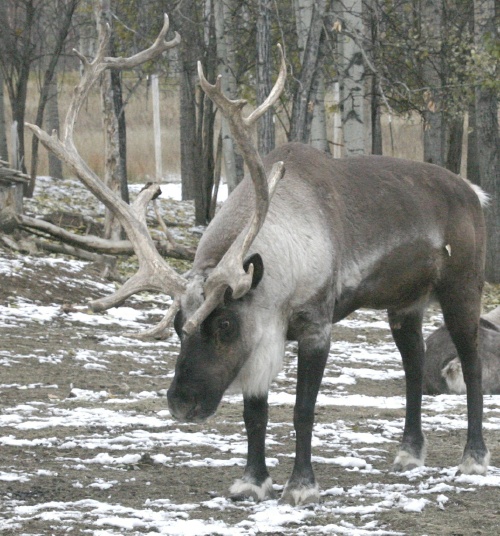One night each year, tiny magic reindeer pull Santa and his toy-filled sleigh around the world. Their names are Dasher, Dancer, Prancer, Vixen, Comet, Cupid, Donner, Blitzen and maybe Rudolph (or Robbie, if you're under the age of 30 - editors), and flying reinder are an impressive feat, especially on a site with some very cranky physicists who take that sort of thing literally.
But what about the non-magical reindeer that don't fly, don't have cool names and who spend each day moving throughout the Alaskan and Canadian tundra hanging out with caribou rather than elves? Don't they deserve some attention too?
On a science site they sure do.
Dr. Perry Barboza is a physiologist at the Institute of Arctic Biology, University of Alaska at Fairbanks, who studies reindeer and their closest cousins, caribou. Barboza explains that some of the characteristics of the Alaskan and Canadian reindeer get overlooked in the Christmas crush.

Credit:Institute of Arctic Biology, University of Alaska
First, what about the gender thing?
Male reindeer shed their thick antlers at the end of mating season in early December. The females also have antlers, but their thinner version stays with them throughout the winter. Does this mean that Rudolph and the team are all females?
“It appears that way,” says Barboza. who also says that while Rudolph’s nose has a very shiny glow, the noses of all other reindeer are furry, and usually white and gray, the colors of their snout.
Are they really fat?
At the start of winter, females may be as much as 50% body fat “seals on hooves,” as Barboza likes to describe them. The fat, which can be a couple of inches thick on their rumps, insulates them from months of cold -- as low as minus 45° F. The fat also provides a source of energy that the body draws on at a time when reindeer must subsist mainly on lichen, a combination of fungus and algae.
More interesting facts about reindeer:
• Reindeer eat plants and herbs. The drying tundra resulting from climate change is leading to the loss of lichen ranges, which may adversely affect reindeer herds.
• Reindeer have bigger fat stores than caribou going into the winter, but both groups are about the same body weight at the end of winter, when they’ve used their stores.
• Males go into winter with much lower fat stores than females, as low as 5%, because they use so much energy during the fall mating season. So, losing the weight of their antlers is probably an energy saver.
• Bulls have a shorter lifespan. They live about six years, while females live 8-9 years. Their shorter lifespan is attributed to the greater energy they expend during mating season, to injuries that occur as they compete with other bulls for mates and to their hormones, which suppress the immune system and leave them vulnerable to even minor infections.
• Reindeer have specially designed coats with hollow hairs that help maintain body heat.
• Their circulatory systems are designed to keep the cooler blood in the reindeer’s limbs from drawing warmth from the warm blood in their core body.
• The fatty acids in their legs become more unsaturated closer to the hoof, which helps prevent the membranes from freezing.
Back to the magical ones. Want to watch them on Christmas Eve?
If you want to watch the mythical (MAGICAL, Scrooges - editors) reindeer fly with Santa on Christmas Eve, simply log on to the US government’s North American Aerospace Defense Command’s (NORAD) special Santa tracking website. They have been tracking Santa and his reindeer for more than 50 years.






Comments